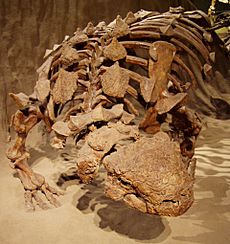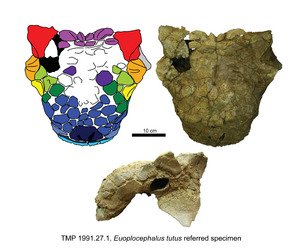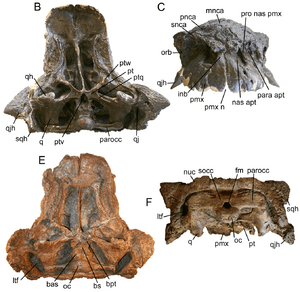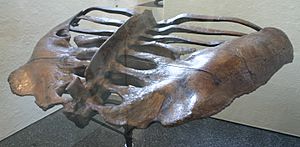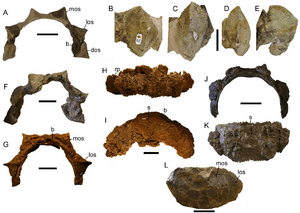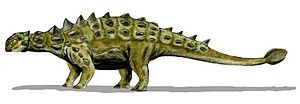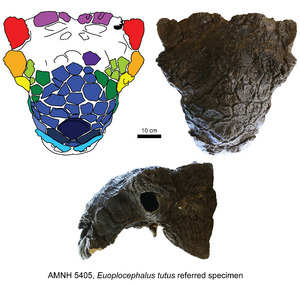Euoplocephalus facts for kids
Quick facts for kids EuoplocephalusTemporal range: Upper Cretaceous 76.5–67 mya
|
|
|---|---|
 |
|
| Scientific classification | |
| Kingdom: | |
| Phylum: | |
| Class: | |
| Superorder: | |
| Order: | |
| Suborder: | |
| Infraorder: | |
| Family: | |
| Genus: |
Euoplocephalus
Lambe, 1910
|
Euplocephalus (meaning "well-armored head") was a large armored dinosaur, measuring about 20 feet (6 m) long; it weighed about 2 tons. Its wide head had a horny, toothless beak, small, peg-like cheek teeth, bony horns, and a small brain. Among its contemporaries were the large meat-eating Tyrannosaurus and Deinonychus.
Fossils from more than 40 individuals have been discovered in Alberta, Canada and Montana in the United States, making Euoplocephalus the best known ankylosaurid. This includes 15 skulls, teeth, and a few almost-complete skeletons, found with the armor still attached. Individual armor plates are the most commonly found element from them.
Contents
Description
Size
Among the ankylosaurids, Euoplocephalus was exceeded in size only by Ankylosaurus, and perhaps Tarchia and Cedarpelta. Euoplocephalus was 5.5 metres (18 ft) long and weighed about 2.5 tonnes (2.8 short tons). It was also 2.4 metres (7.9 ft) wide. Like other ankylosaurids, it had a very broad and flat low-slung torso, about four feet high, positioned on four short legs.
Distinguishing traits
The skull of Euoplocephalus can be distinguished from most other ankylosaurids by several anatomical details, including: the pattern of bony sculpturing in the region in front of the eyes; the form of the palpebral bones (small bones over the eyes), which may have served as bony eyelids; the shallowness of the nasal vestibule at the entrance of the nasal cavity; the medial curve of the tooth rows in the upper jaw; and the teeth, which are relatively small, lacking true cingula, and having variable fluting of the denticles. However, these traits are shared with a number of closely related forms, some of which in the past have been included in the genus. Combining such forms, Walter Coombs and Teresa Maryańska in 1990 stated that Euoplocephalus could be distinguished based on four traits. The premaxillae, the front snout bones, are not covered by dermal ossifications. The external bony nostrils are slit-like, face to the front and are each divided by a vertical bone sheet or septum. The beak has a width equal to or greater than the distance between the rear maxillary, upper cheek, teeth rows. The foot has three digits, metatarsals with toes.
In 2013, Victoria Arbour and Phil Currie provided a differential diagnosis, setting Euoplocephalus apart from its nearest relatives. When compared with Anodontosaurus and Scolosaurus, Euoplocephalus lacks round osteoderms at the base of the squamosal and quadratojugal horns. Compared with Anodontosaurus it lacks small osteoderms at the bases of the large osteoderms on the first cervical half-ring, but, contrary to that genus, does in top view have large rounded osteoderms at the sides of the tail club. It differs from Dyoplosaurus in possessing sacral ribs that perpendicularly point outwards. It differs from Scolosaurus in possessing keeled osteoderms with a round or oval base on the top and sides of the first cervical half-ring and having a shorter rear blade of the ilium. Euoplocephalus differs from Ankylosaurus in possessing anteriorly directed external nostrils and in lacking a continuous keel between the squamosal horn and the supraorbitals.
Skeleton
The skull of Euoplocephalus resembles a truncated equilateral triangle when viewed from above, and is slightly wider than it is long. The largest known skull, that of specimen AMNH 5403, has a length of 411 millimetres and a width of 478 millimetres. Most skull elements are completely fused and two skull openings normally present with dinosaurs, the antorbital fenestra and the upper temporal fenestra, have closed. The skull has nineteen to twenty-four teeth in each upper jaw. The frontmost snout bone, the premaxilla, is toothless. The teeth are very small, with a maximal height and width of just 7.5 millimetres. The strongly drooping snout is blunt, wide and high, and filled with very complex air passages and sinuses, the form and function of which are not yet completely understood. Each side has two external nostrils. The lower jaw has a very concave upper rim with twenty-one teeth. At its front a short low extension is present, to provide contact with the wide predentary, the bony core of the lower horny beak, that fitted within the upper beak of the snout.
As in most quadrupedal ornithischians, its neck is moderately short. The scapula is massive and robust, and the very robust forelimbs are shorter than the hindlimbs. The tail is long and ends in a bony club. Old restorations of Euoplocephalus and rejected synonyms (Dyoplosaurus, Scolosaurus) often show a club with two large vertical spikes. This is an error based on a restoration of Scolosaurus by Franz Nopcsa; the specimen he used had an incomplete tail that stopped just beyond the pair of conical spikes now known to have been positioned halfway along its length. He restored the tail as ending just after the spines. Other artists combined the spikes with the tail club, compounding the inaccuracy. The narrow distal half of the tail is stiffened by bundles of ossified tendons.
The vertebral column of Euoplocephalus is made up of at least seven cervical vertebrae, at least eleven "free" dorsal vertebrae, typically four sacrodorsals forming a fused "sacral rod" in front of the sacrum proper, three "true" sacral vertebrae, and between one and four caudosacrals. Like with other ankylosaurians, the last four dorsal vertebrae and the first caudal vertebra are thus fused to the sacrum, forming a reinforced synsacrum of at least eight vertebrae, the spines of which form a fused supraneural plate, also incorporating the zygapophyses. There are at least twenty-one caudal vertebrae; the total number of caudal vertebrae is uncertain because approximately ten are fused to form part of the tail club, bringing the total to about thirty. This fusion is also seen in other ankylosaurids; it is possible that the extent of fusion is an age-related feature.
The humerus is very robust with strongly expanded upper and lower joints, combined with a narrow shaft. On the upper shaft an enormous deltopectoral crest is present of which the lower part does not gradually merge with the shaft but is warped to the front, forming a thick knob or lip. All this indicates a very heavy musculature. In the lower arm the robust ulna has a well-developed olecranon process. The wrist and hand bones are not well known. In the pelvis, the front blade of the ilium splayed out to the front, reaching all the way to the widest point of the belly to support the gut. This blade also forms a bone shelf at the rear side of the body. The rear blade of the ilium is shorter than the diameter of the hip socket it was located behind, meaning the leg is located at the rear end of the pelvis, near the tail base and much closer to the midline than the belly sides. The pubic bone is unknown. The ischium is a short, curved, vertically positioned bone strap. The thighbone is short, robust and straight with a low fourth trochanter positioned below the midpoint of the shaft. The robust shinbone is shorter than the thighbone. The foot is not well known but functionally tridactyl with hoof-shaped instead of sharp claws.
Armor
The head and body of Euoplocephalus were covered with bony armor, except for parts of the limbs and possibly the distal tail. The armor consisted of osteoderms, skin ossifications that are not part of the skeleton proper. This armor was in 1982 extensively described by Kenneth Carpenter, who however, largely based himself on the very complete specimen NHMUK R5161, the holotype of Scolosaurus, which genus no longer is seen as a synonym of Euoplocephalus. When limited to the certain material of the latter genus, little is known of the exact configuration of the armor, with the exception of the head and the neck. The most informative specimen in this respect would then be ROM 1930, having conserved some osteoderms of the torso in their original position.
In any case, much of the armor was made up of small ossicles, bony round scutes with a diameter of less than five millimetres, of which often hundreds have been found with a single specimen. If the armor was configured in an identical way to that of Scolosaurus, many of these small ossicles had fused into a kind of pavement, forming transverse bands on the body. The banded arrangement is thought to have permitted some freedom of movement. Four of these bands might have been present on the anterior half of the tail, three on the pelvis, perhaps fused into a single "sacral shield", and four across the front part of the torso. Inset in these bands were horizontal rows of larger oval, flat or keeled, scutes. Types of large scutes varied by body region. It might be that the scutes on the shoulder, near the midline of the body, were largest and tallest; ROM 1930 includes some osteoderms with a base length of fifteen centimeters. Little is known about the armor of the limbs. Large keeled plates were present on the upper arms as shown by specimen TMP 1997.132.01 conserving a round osteoderm near the humerus with a diameter of twenty centimeters and narrower spikes associated with the lower arm. The neck was protected by two bone rings, open at the underside, that are called "cervical half-rings". Earlier seen as a fusion of osteoderms, this was doubted by Arbour et al. in 2013, who pointed out that they formed a lower layer, possibly consisting of ossified cartilage, as indicated by a smooth surface and a woven bone texture. Each half-ring is constructed out of six rectangular concave plates, three per side. Each plate has a large keeled osteoderm on top, often not fused with it. With Euoplocephalus, these neck osteoderms do not have smaller osteoderms at their bases, and their keels do not overhang their posterior edges.
The armor of the skull consists of a large number of ossicles, called caputegulae ("head tiles"), that have fused with the normal skull elements, largely fading their sutures. On the snout they form a chaotic and asymmetric mosaic. On the rear nasal region, at the midline a single hexagonal larger plate is present. A keeled plate per side, somewhat more to the back forms the snout rim. Behind the level of the eye sockets the caputegulae fuse into a single bone surface. The upper rim of the eye sockets is formed by two pyramid-shaped osteoderms pointing to the sides and rear. In addition, Euoplocephalus had two pyramid-shaped squamosal "horns" growing from the back corners of its head. Between them the nuchal crest is covered by two osteoderms per side. At the lower rear side of the skull, a quadratojugal horn is present, in the form of an enormous tongue-shaped osteoderm projecting below.
Paleobiology
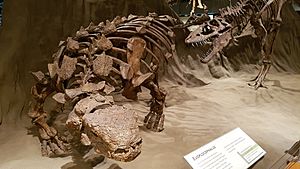
According to Coombs, Euoplocephalus may have had cursorial abilities on par with those of the modern rhinoceros and hippopotamus. Based on the form of the humerus-shoulder articulation and the arrangement of the protracting muscles of the upper arm, it appears that the upper arm sloped away from the body. Coombs and Maryanska (1990) observed that Euoplocephalus specimens are usually discovered as isolated elements or partial skeletons, which suggested that this animal engaged in solitary habits and was usually either solitary or participated in small group clusters.
The armor of Euoplocephalus may have had a keratinous covering, or it may have floated in the skin, as is seen in modern crocodiles. In addition to protection, the heavily-vascularized armor may have had a role in thermoregulation. The palpebral bones over the eyes may have provided additional protection for the eyes. Such bones have with Euoplocephalus been discovered in the upper part of the eye socket, instead of in front of the upper socket rim which is the more common position. Coombs explained this by assuming that these bones were located in the eyelid musculature and were probably mobile enough to be moved over the eyes.
Defense
The tail club of ankylosaurids has often been interpreted as a defensive weapon. In Euoplocephalus, the presence of ossified tendons only with the distal half of the tail may support such a function. Because only the distal half of the tail was stiffened by tendons, the anterior half could still move freely from side to side. The ossified tendons would have transmitted the force of the swing to the club and reinforced the supporting vertebrae. The club was likely held just above the ground, as there was not sufficient musculature to raise the tail very high. A 2009 study concluded that "large ankylosaurian clubs could generate sufficient force to break bone during impacts, while average and small ones could not". It has also concluded that "tail swinging behavior is feasible in ankylosaurids, but it remains unknown whether the tail was used for interspecific defense, intraspecific combat, or both". The tail club could be swung low, toward the fragile metatarsals or shin bones of attacking theropods.
Senses and airflow
Euoplocephalus had relatively small eyes, but this does not necessarily mean that it had restricted vision. The complex respiratory passages observed in the skull suggest that Euoplocephalus had a good sense of smell, although in 1978 an examination of casts of the endocranium did not show an enlarged olfactory region of the brain. Teresa Maryanska, who has worked extensively on Mongolian ankylosaurids, suggested that the respiratory passages were primarily used to perform a mammal-like treatment of inhaled air, based on the presence and arrangement of specialized bones, which are present in Euoplocephalus.
A 2011 study found that the nasal passages of Euoplocephalus were looped and complex; possibly an adaptation for heat and water balance and vocal resonance, and researchers discovered an enlarged and vascularised chamber at the back of the nasal tract, which was considered by the authors to be an adaptation to improve its sense of smell. The researchers also managed to reconstruct the dinosaur's inner ear and concluded that it was capable of hearing at low frequencies. They suggested that this may have been an adaption to hearing low-toned resonant sounds produced by the nasal passages.
Diet
Euoplocephalus, like other ankylosaurians, is thought to have been a herbivore. It had a broad muzzle, which could indicate that it was a non-selective feeder, perhaps similar to a hippopotamus. This would provide niche separation from contemporaneous nodosaurids with narrower muzzles. Ankylosaurians have historically been thought of as feeding using simple up-and-down movements of the jaws. Georg Haas (1969) examined the evidence for the jaw muscles of two skulls (AMNH 5337 and 5405) and concluded that despite the large size of the skulls the associated musculature was relatively weak. He also thought jaw movement was largely orthogonal, in the vertical plane only. Haas extrapolated from this that dinosaurs like Euoplocephalus likely ate relatively soft non-abrasive vegetation.
However, later research indicated that forward and sideways jaw movement was possible, the skull being able to withstand considerable forces. Euoplocephalus appears to have been able to make more complex movements. Tooth wear and jaw articulations (within the lower jaw and at the lower jaw-quadrate joint) suggest that the lower jaws were pulled back during feeding, and also slightly pivoted inward. This action would have sheared food.
See also
 In Spanish: Euoplocephalus tutus para niños
In Spanish: Euoplocephalus tutus para niños


